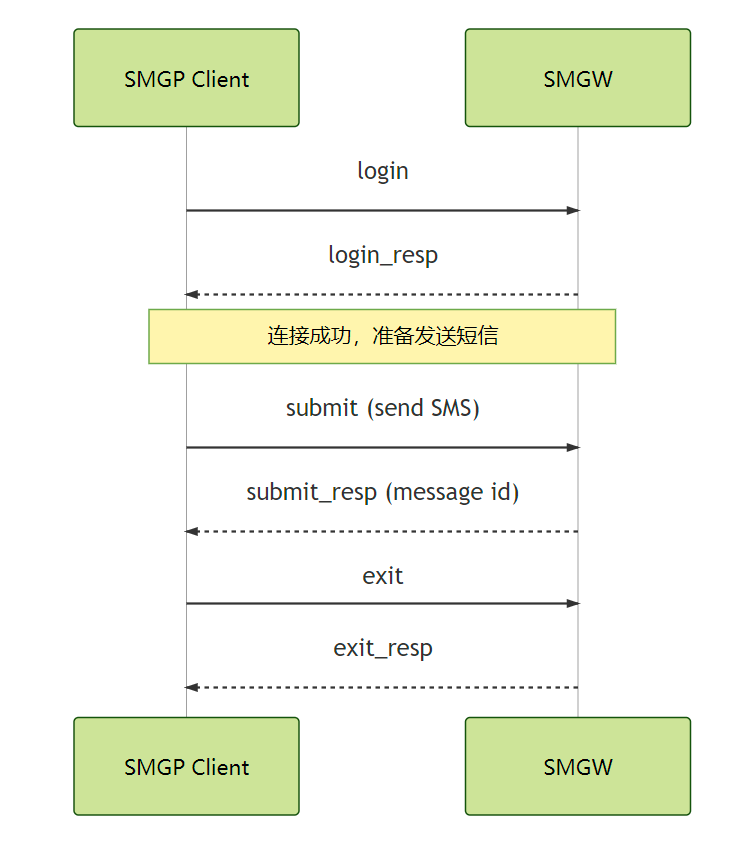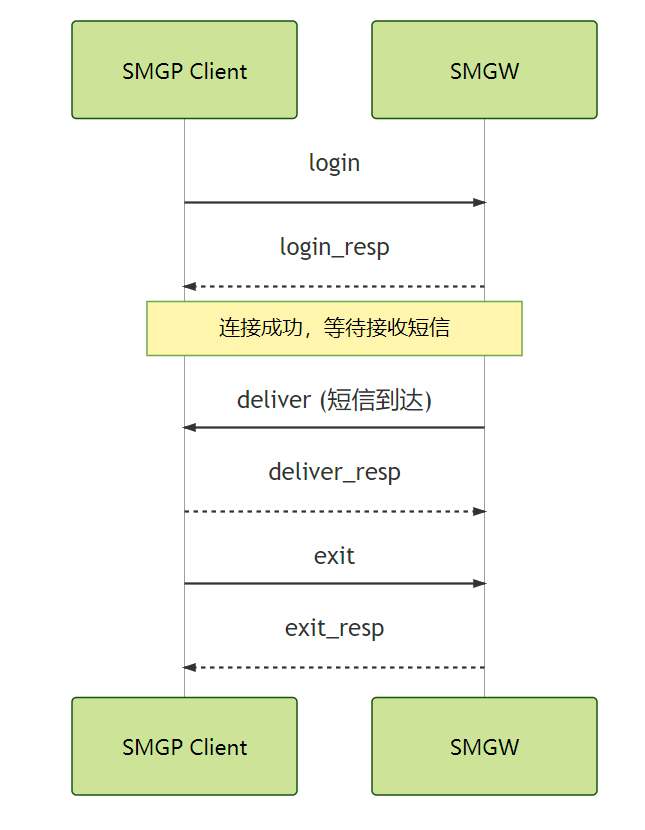本文分享自华为云社区《华为云短信服务教你用Perl实现Smgp协议》,作者:张俭。
引言&协议概述
中国电信短消息网关协议(SMGP)是中国网通为实现短信业务而制定的一种通信协议,全称叫做Short Message Gateway Protocol,用于在短消息网关(SMGW)和服务提供商(SP)之间、短消息网关(SMGW)和短消息网关(SMGW)之间通信。
Perl是一个老牌脚本语言,在众多Linux系统上都会默认安装,比如在ubuntu的22.04版本的基础镜像中,甚至没有Python,但是依然安装了Perl,Perl的普及度可见一斑。Perl的IO::Async模块提供了一套简洁的异步IO编程模型。
SMGP 协议基于客户端/服务端模型工作。由客户端(短信应用,如手机,应用程序等)先和短信网关(SMGW Short Message Gateway)建立起 TCP 长连接,并使用 CNGP 命令与SMGW进行交互,实现短信的发送和接收。在CNGP协议中,无需同步等待响应就可以发送下一个指令,实现者可以根据自己的需要,实现同步、异步两种消息传输模式,满足不同场景下的性能要求。
时序图
连接成功,发送短信

连接成功,从SMGW接收到短信

协议帧介绍

SMGP Header
Header包含以下字段,大小长度都是4字节
- Packet Length:整个PDU的长度,包括Header和Body。
- Request ID:用于标识PDU的类型(例如,Login、Submit等)。
- Sequence Id:序列号,用来匹配请求和响应。
使用perl实现SMGP协议栈里的建立连接
├── Makefile.PL
├── examples
│ └── smgp_client_login_example.pl
└── lib
└── Smgp
├── BoundAtomic.pm
├── Client.pm
├── Constant.pm
└── Protocol.pm
Makefile.PL:用来生成Makefile
examples:存放示例代码
- smgp_client_login_example.pl:存放Smgp的login样例
- BoundAtomic.pm:递增工具类,用来生成SequenceId
- Client.pm:Smgp定义,负责与Smgp服务进行通信,例如建立连接、发送短信等
- Protocol.pm:存放PDU,编解码等
实现sequence_id递增
sequence_id是从1到0x7FFFFFFF的值
package Smgp::BoundAtomic;
use strict;
use warnings FATAL => 'all';
sub new {
my ($class, %args) = @_;
my $self = {
min => $args{min},
max => $args{max},
value => $args{min},
};
bless $self, $class;
return $self;
}
sub increment {
my ($self) = @_;
if ($self->{value} >= $self->{max}) {
$self->{value} = $self->{min};
} else {
$self->{value}++;
}
return $self->{value};
}
sub get {
my ($self) = @_;
return $self->{value};
}
1;
在Perl中定义SMGP PDU以及编解码函数
package Smgp::Protocol;
use strict;
use warnings FATAL => 'all';
use Smgp::Constant;
sub new_login {
my ($class, %args) = @_;
my $self = {
clientId => $args{clientId},
authenticatorClient => $args{authenticatorClient},
loginMode => $args{loginMode},
timeStamp => $args{timeStamp},
version => $args{version},
};
return bless $self, $class;
}
sub encode_login {
my ($self) = @_;
return pack("A8A16CNC", @{$self}{qw(clientId authenticatorClient loginMode timeStamp version)});
}
sub decode_login_resp {
my ($class, $buffer) = @_;
my ($status, $authenticatorServer, $version) = unpack("N4A16C", $buffer);
return bless {
status => $status,
authenticatorServer => $authenticatorServer,
version => $version,
}, $class;
}
sub new_header {
my ($class, %args) = @_;
my $self = {
total_length => $args{total_length},
request_id => $args{request_id},
command_status => $args{command_status},
sequence_id => $args{sequence_id},
};
return bless $self, $class;
}
sub encode_header {
my ($self, $total_length) = @_;
return pack("N3", $total_length, @{$self}{qw(request_id sequence_id)});
}
sub new_pdu {
my ($class, %args) = @_;
my $self = {
header => $args{header},
body => $args{body},
};
return bless $self, $class;
}
sub encode_login_pdu {
my ($self) = @_;
my $encoded_body = $self->{body}->encode_login();
return $self->{header}->encode_header(length($encoded_body) + 12) . $encoded_body;
}
sub decode_pdu {
my ($class, $buffer) = @_;
my ($request_id, $sequence_id) = unpack("N2", substr($buffer, 0, 8));
my $body_buffer = substr($buffer, 8);
my $header = $class->new_header(
total_length => 0,
request_id => $request_id,
sequence_id => $sequence_id,
);
my $body;
if ($request_id == Smgp::Constant::LOGIN_RESP_ID) {
$body = $class->decode_login_resp($body_buffer);
} else {
die "Unsupported request_id: $request_id";
}
return $class->new_pdu(
header => $header,
body => $body,
);
}
1;
constant.pm存放相关requestId
package Smgp::Constant;
use strict;
use warnings FATAL => 'all';
use constant {
LOGIN_ID => 0x00000001,
LOGIN_RESP_ID => 0x80000001,
SUBMIT_ID => 0x00000002,
SUBMIT_RESP_ID => 0x80000002,
DELIVER_ID => 0x00000003,
DELIVER_RESP_ID => 0x80000003,
ACTIVE_TEST_ID => 0x00000004,
ACTIVE_TEST_RESP_ID => 0x80000004,
FORWARD_ID => 0x00000005,
FORWARD_RESP_ID => 0x80000005,
EXIT_ID => 0x00000006,
EXIT_RESP_ID => 0x80000006,
QUERY_ID => 0x00000007,
QUERY_RESP_ID => 0x80000007,
MT_ROUTE_UPDATE_ID => 0x00000008,
MT_ROUTE_UPDATE_RESP_ID => 0x80000008,
};
1;
实现client以及login方法
package Smgp::Client;
use strict;
use warnings FATAL => 'all';
use IO::Socket::INET;
use Smgp::Protocol;
use Smgp::Constant;
sub new {
my ($class, %args) = @_;
my $self = {
host => $args{host} // 'localhost',
port => $args{port} // 9000,
socket => undef,
sequence_id => 1,
};
bless $self, $class;
return $self;
}
sub connect {
my ($self) = @_;
$self->{socket} = IO::Socket::INET->new(
PeerHost => $self->{host},
PeerPort => $self->{port},
Proto => 'tcp',
) or die "Cannot connect to $self->{host}:$self->{port} $!";
}
sub login {
my ($self, $body) = @_;
my $header = Smgp::Protocol->new_header(
request_id => Smgp::Constant::LOGIN_ID,
sequence_id => 1,
);
my $pdu = Smgp::Protocol->new_pdu(
header => $header,
body => $body,
);
$self->{socket}->send($pdu->encode_login_pdu());
$self->{socket}->recv(my $response_length_bytes, 4);
my $total_length = unpack("N", $response_length_bytes);
my $remain_length = $total_length - 4;
$self->{socket}->recv(my $response_data, $remain_length);
return Smgp::Protocol->decode_pdu($response_data)->{body};
}
sub disconnect {
my ($self) = @_;
close($self->{socket}) if $self->{socket};
}
1;
运行example,验证连接成功
package smgp_client_login_example;
use strict;
use warnings FATAL => 'all';
use Smgp::Client;
use Smgp::Protocol;
use Smgp::Constant;
sub main {
my $client = Smgp::Client->new(
host => 'localhost',
port => 9000,
);
$client->connect();
my $login = Smgp::Protocol->new_login(
clientId => '12345678',
authenticatorClient => '1234567890123456',
loginMode => 1,
timeStamp => time(),
version => 0,
);
my $response = $client->login($login);
if ($response->{status} == 0) {
print "Login successful!\n";
}
else {
print "Login failed! Status: ", (defined $response->{status} ? $response->{status} : 'undefined'), "\n";
}
$client->disconnect();
}
main() unless caller;
1;

相关开源项目
- netty-codec-sms 存放各种SMS协议(如cmpp、sgip、smpp)的netty编解码器
- sms-client-java 存放各种SMS协议的Java客户端
- sms-server-java 存放各种SMS协议的Java服务端
- cmpp-python cmpp协议的python实现
- cngp-zig cmpp协议的python实现
- smgp-perl smgp协议的perl实现
- smpp-rust smpp协议的rust实现
总结
本文简单对SMGP协议进行了介绍,并尝试用perl实现协议栈,但实际商用发送短信往往更加复杂,面临诸如流控、运营商对接、传输层安全等问题,可以选择华为云消息&短信(Message & SMS)服务通过HTTP协议接入,华为云短信服务是华为云携手全球多家优质运营商和渠道,为企业用户提供的通信服务。企业调用API或使用群发助手,即可使用验证码、通知短信服务。
标签:Smgp,self,args,Perl,id,ID,my,教你用 From: https://www.cnblogs.com/huaweiyun/p/18174373